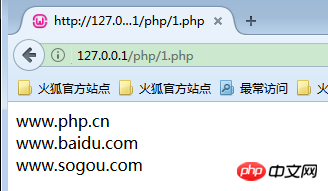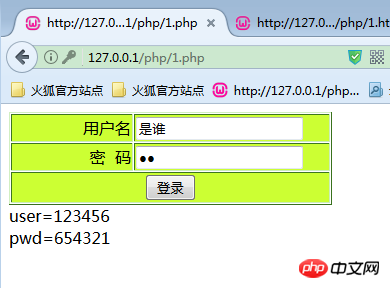 Backend Development
Backend Development
 PHP Tutorial
PHP Tutorial
 How to loop output of an array in php? Introduction to the method of traversing the array
How to loop output of an array in php? Introduction to the method of traversing the array
How to loop output of an array in php? Introduction to the method of traversing the array
Traversing all elements in an array is a common operation, and functions such as queries can be completed during the traversal process. In our daily life, if we want to go to the mall to buy a piece of clothing, we need to walk around the mall to see if we want the clothes we want again. The process of shopping in the mall is equivalent to the operation of traversing an array. There are many ways to traverse arrays in PHP. Here we will introduce you to the two most commonly used methods.
The first one: use the foreach structure to traverse the array
For an array variable $url that contains a large number of URLs, if you use the echo statement to Outputting one by one will be quite tedious, but by traversing the array through the foreach structure, you can easily obtain the data information. The sample code is as follows:
<?php
header("Content-Type:text/html; charset=utf-8");
$url = array(
"PHP中文网"=>"www.php.cn",
"百度" => "www.baidu.com",
"搜狗"=>"www.sogou.com",
); //声明数组
foreach($url as $link){
echo $link.'<br>';
}
?>The traversal result is:

In the above code, PHP executes the loop body (echo statement) once for each element of the array $URL, and assigns $link to the current array element. Each element is processed in the internal order of the array.
Second type: The list() function traverses the array
The list() function assigns the values in the array to some variables. Similar to the array() function, the list() function is not a real function, but a language construct. The list() function can only be used for numerically indexed arrays with indexes starting from 0.
The syntax format is as follows:
void list(mixed ...)
The parameter mixed is the name of the variable to be assigned a value.
The following will explain the comprehensive application of the list() function and each() function through specific examples to obtain the user login information stored in the group number.
The specific development steps are as follows:
1. Use development tools to create a new PHP dynamic page and save it as index.php.
2. Use HTML markup to design the page. First create a user login form to enter user login information, then use the each() function to extract the contents of the global array $_POST, and finally use the white statement to loop and output the attention information submitted by the user.
The sample code is as follows:
<!DOCTYPE html>
<html>
<head>
<meta charset="UTF-8">
<title></title>
</head>
<body>
<!---------------------------------------------定义用户登录表单信息---------------------------------------------------->
<form name="form1" method="post">
<table width="323" border="1" cellpadding="1" cellspacing="1" bordercolor="#66cc33" bgcolor="#FFFFFF">
<tr>
<td width="118" height="24" bgcolor="#CCFF33">用户名</td>
<td width="192" height="24" bgcolor="#CCFF33">
<input type="text" name="user" id="user" size="24">
</td>
</tr>
<tr>
<td height="24" bgcolor="#CCFF33">密 码</td>
<td height="24" bgcolor="#CCFF33">
<input type="password" name="pwd" id="pwd" size="24">
</td>
</tr>
<tr bgcolor="#CCFF33">
<td height="24" colspan="2">
<input type="submit" name="submit" value="登录">
</td>
</tr>
</table>
</form>
</body>
</html>
<?php
//输出用户登录信息
while(list($name,$value)=each($_POST)){
if($name!="submit"){
echo "$name=$value<br>";
}
}
?>3. Enter the address in the browser, press the Enter key, enter the user name and password, click the "Login" button, and the running result is as shown below :

Description:
each() function is used to return the array value of the current pointer position, and at the same time change the pointer Advance to the next location. The returned array contains 4 keys, keys 0 and key contain the key names, and keys 1 and value contain the corresponding data. If the pointer is already at the end of the array when the program executes the each() function, false is returned.
【Related tutorial recommendations】
1. Relevant topic recommendations: "php array (Array) 》
2. Recommended related video courses:
《Using for loop to traverse arrays: index and associative array 》
《Use while loop to traverse arrays: index and associative array》
《Use foreach loop To traverse: index and associative array》
The above is the detailed content of How to loop output of an array in php? Introduction to the method of traversing the array. For more information, please follow other related articles on the PHP Chinese website!

Hot AI Tools

Undresser.AI Undress
AI-powered app for creating realistic nude photos

AI Clothes Remover
Online AI tool for removing clothes from photos.

Undress AI Tool
Undress images for free

Clothoff.io
AI clothes remover

Video Face Swap
Swap faces in any video effortlessly with our completely free AI face swap tool!

Hot Article

Hot Tools

Notepad++7.3.1
Easy-to-use and free code editor

SublimeText3 Chinese version
Chinese version, very easy to use

Zend Studio 13.0.1
Powerful PHP integrated development environment

Dreamweaver CS6
Visual web development tools

SublimeText3 Mac version
God-level code editing software (SublimeText3)

Hot Topics
 PHP 8.4 Installation and Upgrade guide for Ubuntu and Debian
Dec 24, 2024 pm 04:42 PM
PHP 8.4 Installation and Upgrade guide for Ubuntu and Debian
Dec 24, 2024 pm 04:42 PM
PHP 8.4 brings several new features, security improvements, and performance improvements with healthy amounts of feature deprecations and removals. This guide explains how to install PHP 8.4 or upgrade to PHP 8.4 on Ubuntu, Debian, or their derivati
 7 PHP Functions I Regret I Didn't Know Before
Nov 13, 2024 am 09:42 AM
7 PHP Functions I Regret I Didn't Know Before
Nov 13, 2024 am 09:42 AM
If you are an experienced PHP developer, you might have the feeling that you’ve been there and done that already.You have developed a significant number of applications, debugged millions of lines of code, and tweaked a bunch of scripts to achieve op
 How To Set Up Visual Studio Code (VS Code) for PHP Development
Dec 20, 2024 am 11:31 AM
How To Set Up Visual Studio Code (VS Code) for PHP Development
Dec 20, 2024 am 11:31 AM
Visual Studio Code, also known as VS Code, is a free source code editor — or integrated development environment (IDE) — available for all major operating systems. With a large collection of extensions for many programming languages, VS Code can be c
 Explain JSON Web Tokens (JWT) and their use case in PHP APIs.
Apr 05, 2025 am 12:04 AM
Explain JSON Web Tokens (JWT) and their use case in PHP APIs.
Apr 05, 2025 am 12:04 AM
JWT is an open standard based on JSON, used to securely transmit information between parties, mainly for identity authentication and information exchange. 1. JWT consists of three parts: Header, Payload and Signature. 2. The working principle of JWT includes three steps: generating JWT, verifying JWT and parsing Payload. 3. When using JWT for authentication in PHP, JWT can be generated and verified, and user role and permission information can be included in advanced usage. 4. Common errors include signature verification failure, token expiration, and payload oversized. Debugging skills include using debugging tools and logging. 5. Performance optimization and best practices include using appropriate signature algorithms, setting validity periods reasonably,
 PHP Program to Count Vowels in a String
Feb 07, 2025 pm 12:12 PM
PHP Program to Count Vowels in a String
Feb 07, 2025 pm 12:12 PM
A string is a sequence of characters, including letters, numbers, and symbols. This tutorial will learn how to calculate the number of vowels in a given string in PHP using different methods. The vowels in English are a, e, i, o, u, and they can be uppercase or lowercase. What is a vowel? Vowels are alphabetic characters that represent a specific pronunciation. There are five vowels in English, including uppercase and lowercase: a, e, i, o, u Example 1 Input: String = "Tutorialspoint" Output: 6 explain The vowels in the string "Tutorialspoint" are u, o, i, a, o, i. There are 6 yuan in total
 How do you parse and process HTML/XML in PHP?
Feb 07, 2025 am 11:57 AM
How do you parse and process HTML/XML in PHP?
Feb 07, 2025 am 11:57 AM
This tutorial demonstrates how to efficiently process XML documents using PHP. XML (eXtensible Markup Language) is a versatile text-based markup language designed for both human readability and machine parsing. It's commonly used for data storage an
 Explain late static binding in PHP (static::).
Apr 03, 2025 am 12:04 AM
Explain late static binding in PHP (static::).
Apr 03, 2025 am 12:04 AM
Static binding (static::) implements late static binding (LSB) in PHP, allowing calling classes to be referenced in static contexts rather than defining classes. 1) The parsing process is performed at runtime, 2) Look up the call class in the inheritance relationship, 3) It may bring performance overhead.
 What are PHP magic methods (__construct, __destruct, __call, __get, __set, etc.) and provide use cases?
Apr 03, 2025 am 12:03 AM
What are PHP magic methods (__construct, __destruct, __call, __get, __set, etc.) and provide use cases?
Apr 03, 2025 am 12:03 AM
What are the magic methods of PHP? PHP's magic methods include: 1.\_\_construct, used to initialize objects; 2.\_\_destruct, used to clean up resources; 3.\_\_call, handle non-existent method calls; 4.\_\_get, implement dynamic attribute access; 5.\_\_set, implement dynamic attribute settings. These methods are automatically called in certain situations, improving code flexibility and efficiency.





